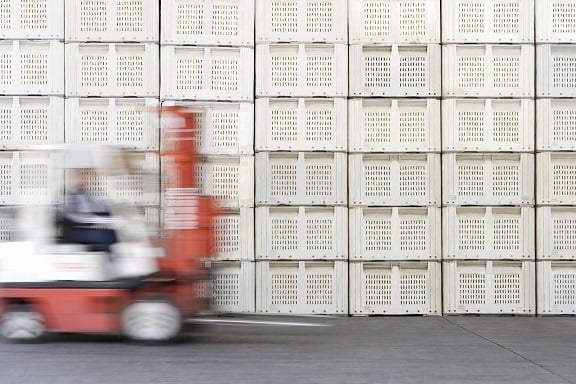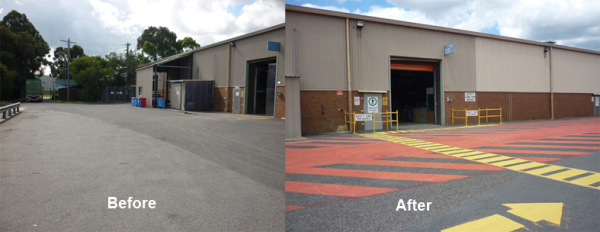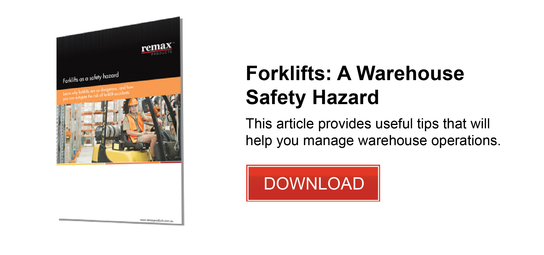Creating a warehouse traffic management plan
5 key features to include to ensure forklift safety
At heart a warehouse’s traffic management plan involves identifying and dealing with risks. Many warehouses operate around the clock, which makes a traffic management plan crucial to smooth uninterrupted operation.
Any failure in the plan will result in a loss of warehouse efficiency, potentially causing deadlines to be missed and revenue lost. It can also result in product, equipment and facility damage, and in the worst case severe injuries and even death.

Your warehouse’s traffic management plan needs to alleviate risk by accounting for optimal traffic flow and worst-case scenarios. Warehouse accidents are more prevalent than you would believe. Accidents involving loss of money and stock, or damage to equipment, are common. Last year alone there were 34,900 recorded forklift accidents involving serious injury and 61,800 non-serious accidents. Yet despite the best intentions of managers and warehouse operators, accidents can be difficult to eliminate.
In creating a traffic management plan you should consider more than a simple detailing of how forklifts move around the warehouse. Your plan should include everything from the warehouse’s design blueprint, up to forklift drivers waving each other on at intersections. To help you with this, below are five key features which all well-designed traffic management plans should include.
1) Vehicle routes
You need to think of vehicle routes as more than just lanes for moving vehicles, your routes also involve vehicles stopping rapidly, sitting at rest, passing and reversing. To deal with all this traffic you should attempt to keep your lanes one-way if possible, and design them with separate entry and exit points for larger vehicles.
You also need to ensure the route surface is a well-drained material such as bitumen or concrete in order increase grip and prevent slippage.

In addition to choosing the correct surface, you should always keep it free of hazards such as oil, slippery substances, potholes or other surface damage. All of these hazards affect stopping distances, maximum speeds and vehicle wear.
Another hazard to avoid is excessively steep gradients, as they create instability in forklifts and other vehicles in your warehouse. Your drivers will probably be having lunch every day and they may also have other routine activities, your vehicle routes should be adjusted to accommodate these routines without hindering traffic.
Lane width may seem like a mundane concern, but it is one of the crucial indicators of a fully optimised warehouse. Lanes need to have a buffer zone slightly larger than the widest load of your largest vehicle. While increasing lane width will reduce the risk of accidents and collisions the opposing concern is having lanes narrow enough to maximise storage space. By correctly balancing the need for safety and the maximum storage area possible, you can find an optimal size of your warehouse.
2) Warehouse signage
Consider signage as something that not so much tells drivers and operators what to do, but rather reminds them of things they already know.
Reflective markers and lines will help guide them on the correct path and easy to read signs will alert them to things of importance in that area. Remember when choosing your signs that they will need to be legible at high speed and often they will be far above eye level. You should test their readability under both conditions. Clear signage should be used to alert drivers to:
- Exclusion zones
- Parking/no parking zones
- Speed limits
- Pedestrian crossings
- Vehicle crossings
- Blind corners
- Steep gradients, and
- Other known hazards.
3) Protection for employees
Just as employees wear protective clothing for different situations, you should consider the activities your warehouse endures and protect its areas of vulnerability and most wear.
Things such as bollards can be useful in protecting important parts of the warehouse and when used around traffic areas can also alert pedestrians to dangerous zones and prevent them from walking into oncoming traffic.
To reduce wear on the structural features of your facility you can use bump rails or rub rails, these can extend your warehouse’s life and also the lives of the vehicles or parts that cause the rubbing. These protective measures will extend the life of your facility and vehicles and they should be put in place regardless of whether you have had previous accidents or not.
4) Safe crossings and pedestrian zones
Pedestrian zones should be clearly demarcated and physically separated so that vehicles cannot enter. If it is not possible to physically separate pedestrian and vehicle zones you should be aware of other options such as vision panels in doors, mirrors for pedestrian and vehicle use, natural pedestrian routes that people would follow anyway and clearly marked footpaths that are obvious to both the people walking them and the vehicles avoiding them.
Barriers should be used not just to stop traffic but also, as mentioned above, to remind pedestrians of entrances and exits when moving through the warehouse. Should pedestrians need to cross vehicle routes at your warehouse, you need to think about separating the two areas.
Overhead walkways are the safest and best option. But where these are not appropriate, think about offering protection through the use of physical barriers with inward opening gates, gates with warning devices, and the use of traffic light systems.
These control measures should also be combined with clearly visible ground markings, lights and signs.
5) Training and understanding
Supplementary to any measure you take it is necessary that every person who enters your facility understands your traffic management plan. They should be aware of designated safe routes, no-go zones and speed limits. The simplest way to do this is running an induction process.
For visitors you should also provide a supervisor to ensure their safety and protection when navigating your warehouse. Even the best traffic management plan can fail if not correctly explained to everyone involved. Training is critical and many types of vehicles require operators to have high risk work licences, make sure that your warehouse maintains a high standard of employment because even the most well designed warehouse can be destroyed by an inexperienced or bad operator.
Remember that the most crucial step comes after correct risk identification, assessment and implementation of prevention strategies, it is the review. This is the step where you assess whether your strategies have been effective and how they could be improved.
Without this step, your traffic management plan will be unable to keep up with the advancements offered by new technology, products and staff experience. This will result either in your inability to use the more efficient processes or the risk associated with using them when your warehouse is not designed to meet the new demands put upon it.
Find out more about warehouse traffic management plans
If you would like more information about creating a warehouse traffic management plan contact the expert Remax team online or call 1800 010 221.






